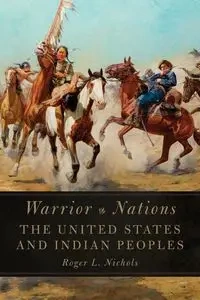Warrior Nations - Roger L. Nichols
Warrior Nations - Roger L. Nichols
- The United States and Indian Peoples
AutorzyRoger L. Nichols
EAN: 9780806143828
Symbol
483GTC03527KS
Rok wydania
2013
Strony
252
Oprawa
Miekka
Format
15.2x22.9cm
Język
angielski

Bez ryzyka
14 dni na łatwy zwrot

Szeroki asortyment
ponad milion pozycji

Niskie ceny i rabaty
nawet do 50% każdego dnia
Niepotwierdzona zakupem
Ocena: /5
Symbol
483GTC03527KS
Kod producenta
9780806143828
Rok wydania
2013
Strony
252
Oprawa
Miekka
Format
15.2x22.9cm
Język
angielski
Autorzy
Roger L. Nichols

During the century following George Washington's presidency, the United States fought at least forty wars with various Indian tribes, averaging one conflict every two and a half years. Warrior Nations is Roger L. Nichols's response to the question, "Why did so much fighting take place?" Examining eight of the wars between the 1780s and 1877, Nichols explains what started each conflict and what the eight had in common as well as how they differed. He writes about the fights between the United States and the Shawnee, Miami, and Delaware tribes in the Ohio Valley, the Creek in Alabama, the Arikara in South Dakota, the Sauk and Fox in Illinois and Wisconsin, the Dakota Sioux in Minnesota, the Cheyenne and Arapaho in Colorado, the Apache in New Mexico and Arizona, and the Nez Perce in Oregon and Idaho.
Virtually all of these wars, Nichols shows, grew out of small-scale local conflicts, suggesting that interracial violence preceded any formal declaration of war. American pioneers hated and feared Indians and wanted their land. Indian villages were armed camps, and their young men sought recognition for bravery and prowess in hunting and fighting. Neither the U.S. government nor tribal leaders could prevent raids, thievery, and violence when the two groups met.
In addition to U.S. territorial expansion and the belligerence of racist pioneers, Nichols cites a variety of factors that led to individual wars: cultural differences, border disputes, conflicts between and within tribes, the actions of white traders and local politicians, the government's failure to prevent or punish anti-Indian violence, and Native determination to retain their lands, traditional culture, and tribal independence.
The conflicts examined here, Nichols argues, need to be considered as wars of U.S. aggression, a central feature of that nation's expansion across the continent that brought newcomers into areas occupied by highly militarized Native communities ready and able to defend themselves and attack their enemies.
Roger L. Nichols is Professor of History at the University of Arizona and author of Indians in the United States and Canada: A Comparative History
EAN: 9780806143828
EAN: 9780806143828
Niepotwierdzona zakupem
Ocena: /5
Zapytaj o produkt
Niepotwierdzona zakupem
Ocena: /5
Napisz swoją opinię

